“Books Help Us Slow Down” is the theme for this year’s International Children’s Book Day on April 2 (the birthday of Hans Christian Andersen), sponsored by the International Board on Books for Young People. In this week’s column, we review books by authors and illustrators from countries around the world to share with young people in celebration of this annual event.
Ages 4–8
Angry Cookie. Laura Dockrill. Ill. Maria Karipidou. 2019. Walker/Candlewick.
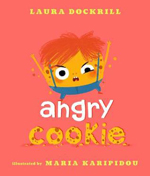 “Close this book this very second, you nosy noodle. Don’t even think about turning the page.” After numerous pages in which a redheaded chocolate chip cookie persists in demanding that the reader close this book because he’s very angry and there is nothing the reader can do about it, he gives up and proceeds to enumerate all the things that happened to him the previous day that made him so angry. Finally, realizing the reader is still with him and listening, the cookie decides he’s not angry any more. He’s happy. A witty text and colorful, digitally created cartoonlike illustrations offer a gentle lesson on sticking with a friend even when they are acting like “an angry cookie.”(Laura Dockrill lives in England and Maria Karipidou lives in Germany.)
“Close this book this very second, you nosy noodle. Don’t even think about turning the page.” After numerous pages in which a redheaded chocolate chip cookie persists in demanding that the reader close this book because he’s very angry and there is nothing the reader can do about it, he gives up and proceeds to enumerate all the things that happened to him the previous day that made him so angry. Finally, realizing the reader is still with him and listening, the cookie decides he’s not angry any more. He’s happy. A witty text and colorful, digitally created cartoonlike illustrations offer a gentle lesson on sticking with a friend even when they are acting like “an angry cookie.”(Laura Dockrill lives in England and Maria Karipidou lives in Germany.)
—CA
Birds. Carme Lemniscates. 2019. Candlewick Studio/Candlewick.
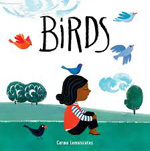 “Birds come in many different colors, shapes, and personalities.” Beginning with the first double-page spread featuring portraits of 12 colorful birds, a spare text and bright, mixed-media illustrations celebrate the diversity of birds in physical characteristics, habitats, and behaviors. And as the young narrator spends the day out of doors, she shares her thoughts about the many ways in which birds are such an awe-inspiring part of the world in which we live—from how their happy songs greet us in the morning to how they are free to fly away and make our imaginations soar. None of the birds are named, which offers the opportunity for adults sharing the book with young children to identify them as they talk about each page. (The author–illustrator lives in Spain.)
“Birds come in many different colors, shapes, and personalities.” Beginning with the first double-page spread featuring portraits of 12 colorful birds, a spare text and bright, mixed-media illustrations celebrate the diversity of birds in physical characteristics, habitats, and behaviors. And as the young narrator spends the day out of doors, she shares her thoughts about the many ways in which birds are such an awe-inspiring part of the world in which we live—from how their happy songs greet us in the morning to how they are free to fly away and make our imaginations soar. None of the birds are named, which offers the opportunity for adults sharing the book with young children to identify them as they talk about each page. (The author–illustrator lives in Spain.)
—CA
The Home Builders. Varsha Bajaj. Ill. Simona Mulazzani. 2019. Nancy Paulsen/Penguin.
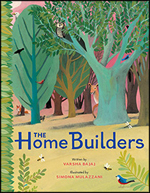 A series of questions—Do you see the home builders? Do you see the builders work? Do you see the homes? Do you see the babies? Do you see the families?—followed by a rhythmic text (with an ABCB rhyme scheme) focuses the reader’s attention on colorful mixed-media illustrations of idyllic woodland scenes showing animal parents digging, gnawing, gathering, and constructing homes in anticipation of the birth of their young (beaver kits, owlets, mole pups, and more) and raising them. This engaging format invites young children to point out and identify the various parents and their offspring on the detailed, double-page spreads. (Varsha Bajaj grew up in India and now lives in Texas and Simona Mulazzani lives in Italy.)
A series of questions—Do you see the home builders? Do you see the builders work? Do you see the homes? Do you see the babies? Do you see the families?—followed by a rhythmic text (with an ABCB rhyme scheme) focuses the reader’s attention on colorful mixed-media illustrations of idyllic woodland scenes showing animal parents digging, gnawing, gathering, and constructing homes in anticipation of the birth of their young (beaver kits, owlets, mole pups, and more) and raising them. This engaging format invites young children to point out and identify the various parents and their offspring on the detailed, double-page spreads. (Varsha Bajaj grew up in India and now lives in Texas and Simona Mulazzani lives in Italy.)
—CA
It’s a Girl Thing!: Smart, Fierce, and Leading the Way. Pri Ferrari. 2019. StarBerry/Kane.
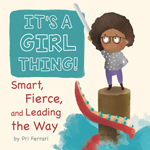 “What's a girl thing? What do girls like to do? What can girls be?” These introductory questions are followed by a series of brief patterned answers and clever mixed-media illustrations of girls involved in various activities. “Girls are..." statements are completed with professions: pilots, archeologists, chefs, mountain climbers, doctors, astronauts, creators, musicians, mechanics, gamers, business owners, chemists, adventurers, architects, and bus drivers. For example, “Girls are PILOTS. / They can fly helicopters, airplanes, / rockets...and even dragons” is paired with an image of a girl flying on a dragon. The last few pages describe characteristics of girls as brave, strong, and powerful, ending with “A Girl Thing is EVERYTHING!” (Pri Ferrari lives in Brazil.)
“What's a girl thing? What do girls like to do? What can girls be?” These introductory questions are followed by a series of brief patterned answers and clever mixed-media illustrations of girls involved in various activities. “Girls are..." statements are completed with professions: pilots, archeologists, chefs, mountain climbers, doctors, astronauts, creators, musicians, mechanics, gamers, business owners, chemists, adventurers, architects, and bus drivers. For example, “Girls are PILOTS. / They can fly helicopters, airplanes, / rockets...and even dragons” is paired with an image of a girl flying on a dragon. The last few pages describe characteristics of girls as brave, strong, and powerful, ending with “A Girl Thing is EVERYTHING!” (Pri Ferrari lives in Brazil.)
—NB
Lubna and Pebble. Wendy Meddour. Ill. Daniel Egnéus. 2019. Dial/Penguin.
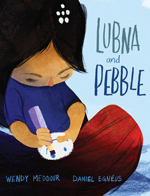 After Lubna and her father arrive at the “World of Tents” as displaced persons, a small rock she names Pebble becomes her constant companion and best friend. She tells Pebble everything “About her brothers. About home. About the war.” When the weather turns cold, Lubna’s father gives her a tea towel and a shoebox in which to keep Pebble warm. Lubna befriends Amir, a little boy who arrives at the camp, and introduces him to Pebble. Amir cries when she tells him she is leaving for a new home, and Lubna gives him Pebble. Vibrant illustrations complement this emotionally powerful refugee story of friendship and compassion. (Wendy Meddour lives in England and Daniel Egnéus lives in Greece.)
After Lubna and her father arrive at the “World of Tents” as displaced persons, a small rock she names Pebble becomes her constant companion and best friend. She tells Pebble everything “About her brothers. About home. About the war.” When the weather turns cold, Lubna’s father gives her a tea towel and a shoebox in which to keep Pebble warm. Lubna befriends Amir, a little boy who arrives at the camp, and introduces him to Pebble. Amir cries when she tells him she is leaving for a new home, and Lubna gives him Pebble. Vibrant illustrations complement this emotionally powerful refugee story of friendship and compassion. (Wendy Meddour lives in England and Daniel Egnéus lives in Greece.)
—NB
The Neighbors. Einat Tsarfati. Trans. Annette Appel. 2019. Abrams.
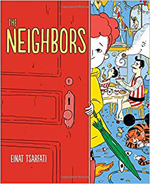 As a girl climbs the stairs to her family’s seventh-floor apartment, she stops at the door on each floor and, based upon its distinctive appearance, describes the unit’s occupants. For example, muddy footprints outside the second door suggest to her that an old explorer and his pet tiger live there and, because the lights always shut off when she reaches the fourth floor, the apartment belongs to a vampire. Each double-page spread featuring the girl’s stop at a door is followed by a colorful, intricately detailed illustration of the apartment’s décor and activities in it according to her wild imaginings. When she unlocks the seventh door, she’s at home with her “so boring” parents. But after she’s asleep, readers discover that her parents lead a not-so-ordinary life. (The author–illustrator lives in Israel.)
As a girl climbs the stairs to her family’s seventh-floor apartment, she stops at the door on each floor and, based upon its distinctive appearance, describes the unit’s occupants. For example, muddy footprints outside the second door suggest to her that an old explorer and his pet tiger live there and, because the lights always shut off when she reaches the fourth floor, the apartment belongs to a vampire. Each double-page spread featuring the girl’s stop at a door is followed by a colorful, intricately detailed illustration of the apartment’s décor and activities in it according to her wild imaginings. When she unlocks the seventh door, she’s at home with her “so boring” parents. But after she’s asleep, readers discover that her parents lead a not-so-ordinary life. (The author–illustrator lives in Israel.)
—CA
Ages 9–11
The Real Boat. Marina Aromshtam. Trans. Olga Varshaver. Ill. Victoria Semykina. 2019. Templar/Candlewick.
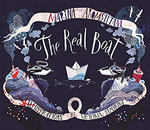 Marina Aromshtam relates the story of the quest of a small paper boat floating in a pond to become a real boat. Navigating its way through a river, a stream, and a harbor, the paper boat finally reaches the ocean. During a storm, the paper boat sinks to the ocean floor but, fortunately, is rescued by a diver who takes it to his research vessel. Upon being given the paper boat, the ship’s captain says, “You’re so tiny—you must have sailed so far! / A true seafarer! / A real boat!” The paper boat, now a real boat named Intrepid, “sighed happily” from inside its new glass bottle. Victoria Semykina’s colorful, mixed-media illustrations express the textures, smells, and sounds of the ocean (along with the personalities of every boat or ship the paper boat meets along the way) and imaginatively celebrate the determination of an adventurous paper boat. (Marina Aromshtam and Victoria Semykina live in Russia.)
Marina Aromshtam relates the story of the quest of a small paper boat floating in a pond to become a real boat. Navigating its way through a river, a stream, and a harbor, the paper boat finally reaches the ocean. During a storm, the paper boat sinks to the ocean floor but, fortunately, is rescued by a diver who takes it to his research vessel. Upon being given the paper boat, the ship’s captain says, “You’re so tiny—you must have sailed so far! / A true seafarer! / A real boat!” The paper boat, now a real boat named Intrepid, “sighed happily” from inside its new glass bottle. Victoria Semykina’s colorful, mixed-media illustrations express the textures, smells, and sounds of the ocean (along with the personalities of every boat or ship the paper boat meets along the way) and imaginatively celebrate the determination of an adventurous paper boat. (Marina Aromshtam and Victoria Semykina live in Russia.)
—NB
The Secret Cat. Katarina Strömgård. 2019. Eerdmans.
 One night in bed, Lucy, whose mother won’t let her have a pet, hears something scratching in the wall, guesses its name is Silvring, and then sees a ghostly looking cat clawing through the wallpaper. After she feeds and plays with Silvring (who continues to grow throughout the story), they go for a nighttime walk and meet other people walking their secret pets (a winged dinosaur, a floating scarlet carp, a seal, a polar bear). But not all secret pets are nice. When she and Silvring are chased by Danger, a big, scary bird, Silvring (now huge) fights and scares Danger away, and they return home to sleep. In the morning, Lucy’s secret pet is gone. She’ll have to wait until night to whisper, “Silvring, come out!” Watercolor-and-ink illustrations in pinks and blues set the mood for this magical nighttime fantasy with just the right amount of scariness. (Katarina Strömgård lives in Sweden.)
One night in bed, Lucy, whose mother won’t let her have a pet, hears something scratching in the wall, guesses its name is Silvring, and then sees a ghostly looking cat clawing through the wallpaper. After she feeds and plays with Silvring (who continues to grow throughout the story), they go for a nighttime walk and meet other people walking their secret pets (a winged dinosaur, a floating scarlet carp, a seal, a polar bear). But not all secret pets are nice. When she and Silvring are chased by Danger, a big, scary bird, Silvring (now huge) fights and scares Danger away, and they return home to sleep. In the morning, Lucy’s secret pet is gone. She’ll have to wait until night to whisper, “Silvring, come out!” Watercolor-and-ink illustrations in pinks and blues set the mood for this magical nighttime fantasy with just the right amount of scariness. (Katarina Strömgård lives in Sweden.)
—NB
Ages 12–14
Stolen Girl. Marsha Forchuk Skrypuch. 2019. Scholastic.
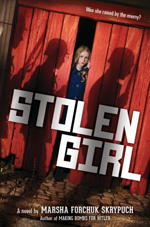 In 1950, 12-year-old Nadia arrives in Brantford, Ontario, with her Ukrainian adoptive mother, Marusia Kravchuk, after living in a European displaced persons camp for five years. Nadia is haunted by incomplete and confusing memories of World War II. Through nightmares and flashbacks, she relives the trauma of her childhood and learns that she is not German Gretchen, part of the family of SS General Himmel, but Larissa, a Ukrainian girl whose Tato was killed by the Soviets and Mama was killed by the Nazis. Finally, knowing her history, Nadia is ready to face the future. The author’s note provides information on the Nazi’s Lebensborn program, which stole blond, blue-eyed Polish and Ukrainian children and placed those considered “racially valuable” with German families, and the Ostarbeiters, Eastern European young adults the Nazis forced to work in munitions factories.(Ukrainian Canadian Marsha Forchuk Skrypuch lives in Brantford, Ontario.)
In 1950, 12-year-old Nadia arrives in Brantford, Ontario, with her Ukrainian adoptive mother, Marusia Kravchuk, after living in a European displaced persons camp for five years. Nadia is haunted by incomplete and confusing memories of World War II. Through nightmares and flashbacks, she relives the trauma of her childhood and learns that she is not German Gretchen, part of the family of SS General Himmel, but Larissa, a Ukrainian girl whose Tato was killed by the Soviets and Mama was killed by the Nazis. Finally, knowing her history, Nadia is ready to face the future. The author’s note provides information on the Nazi’s Lebensborn program, which stole blond, blue-eyed Polish and Ukrainian children and placed those considered “racially valuable” with German families, and the Ostarbeiters, Eastern European young adults the Nazis forced to work in munitions factories.(Ukrainian Canadian Marsha Forchuk Skrypuch lives in Brantford, Ontario.)
—CA
Ages 15+
The Truth and Lies of Ella Black. Emily Barr. 2019. Philomel/Penguin.
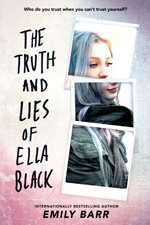 Each chapter begins with a countdown to a death as 17-year-old Ella Black, who has a war waging within her between Ella, the good girl everyone sees and who is bullied, and Bella, the bad girl whose thoughts and actions she fights to control and keep secret, has her life turned upside down when her overprotective parents fly with her to Rio de Janeiro without notice. Snooping in their hotel room’s safe, Ella discovers that she is adopted and that her birth mother has been released from prison after serving time as an accomplice for the murder of five girls. On the run, Ella (urged on by Bella) survives through a series of name changes and relationships and ends up teaching art in a Brazilian ghetto. After the dramatic countdown to “One Hour,” the last chapter, “One Year Later,” brings an additional twist, with the last words, “The phone rang.” (Emily Barr lives in England.)
Each chapter begins with a countdown to a death as 17-year-old Ella Black, who has a war waging within her between Ella, the good girl everyone sees and who is bullied, and Bella, the bad girl whose thoughts and actions she fights to control and keep secret, has her life turned upside down when her overprotective parents fly with her to Rio de Janeiro without notice. Snooping in their hotel room’s safe, Ella discovers that she is adopted and that her birth mother has been released from prison after serving time as an accomplice for the murder of five girls. On the run, Ella (urged on by Bella) survives through a series of name changes and relationships and ends up teaching art in a Brazilian ghetto. After the dramatic countdown to “One Hour,” the last chapter, “One Year Later,” brings an additional twist, with the last words, “The phone rang.” (Emily Barr lives in England.)
—NB
Nancy Brashear is Professor Emeritus of English, Azusa Pacific University, in Azusa, California. Carolyn Angus is former director of the George G. Stone Center for Children's Books, Claremont Graduate University, in Claremont, California.
These reviews are submitted by members of the International Literacy Association's Children's Literature and Reading Special Interest Group (CL/R SIG) and are published weekly on Literacy Daily.